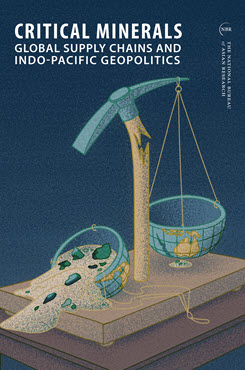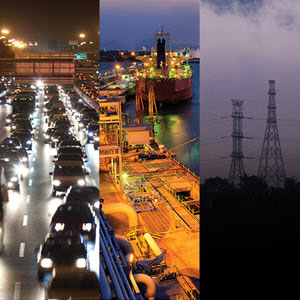NBR Special Report No. 102
Critical Minerals: Global Supply Chains and Indo-Pacific Geopolitics
This report from NBR’s Energy Security Program assesses the risks associated with the growing scarcity of critical minerals. The four essays focus, respectively, on the geographic concentration of critical minerals in a small number of countries (especially China), Australia’s role as a key supplier, lessons from Japan’s and South Korea’s progress in building resilient supply chains, and the outlook for the United States.
Foreword
As the global transition to a cleaner, more sustainable energy mix accelerates, demand is mushrooming for a wide range of critical minerals central to clean energy technologies. The world is transitioning from a fossil fuel–intensive to a minerals-intensive energy economy. These minerals include lithium, cobalt, nickel, graphite, rare earth elements, and a whole range of other more traditional minerals like copper and zinc. At the same time, the world energy system is also shifting toward an electricity-driven final energy use to broaden the availability of energy supplies and take advantage of cleaner sources of electricity generation.
The enormous expansion of the global electric vehicle (EV) market is a key driver in rising demand for minerals critical to battery production. Given that batteries make up roughly onequarter of the cost of an EV, inexpensive and accessible supplies of these minerals are key to making EVs popular, affordable, and commercially viable to compete with the internal combustion engine. EV manufacturing requires enormous amounts of copper and zinc, which, in addition to aluminum, are used in the expansion of renewables like solar and wind power. Moreover, utilityscale battery storage technology, which is vital to addressing the intermittency challenge posed by renewable power generation, requires huge amounts of these critical minerals.
Hence, governments and companies are scrambling to mobilize the mining, transportation, processing, and manufacturing of products from critical minerals in order to meet ever-increasing global ambitions for reducing greenhouse gas emissions and addressing climate change. Countries that hold large reserves of these minerals are working to craft new investment and policy strategies to maximize the benefits of this potential source of wealth for their economies, people, and national security.
However, the scramble for new mineral supplies and processing capacity is not taking place in a geopolitical vacuum. The new geopolitics of clean energy is being shaped by intensifying strategic competition as well as powerful recent shocks to global supply chains that are fundamentally changing the way that countries and companies organize their supply systems and production chains.
Most importantly, control over critical mineral supply, processing, and clean technology manufacturing is becoming a significant new element in the widening strategic and economic competition between the United States and China. Since the outbreak of the U.S.-China trade war and implementation of tariffs in 2018, U.S. companies have begun to pursue, and the U.S. government has encouraged, the development of more diversified supply chains away from China. But China and its companies have more than a decade lead in accessing and mining critical mineral supplies around the world and developing a large critical mineral processing sector and possess world-leading EV, battery, and renewables manufacturing capacities. In this environment, U.S. clean energy policies incentivizing investments in critical minerals, processing, and manufacturing are now explicitly linked to developing supply chains excluding China. This will prove very challenging.
Another factor in heightened competition for critical minerals is the Covid-19 pandemic. Lockdowns to curb the spread of the virus hammered global supply chains for everything from food to semiconductors and further incentivized companies and countries to diversify and secure their supply chains. This continues to influence the pattern of investments in mining, processing, and manufacturing of critical minerals.
Finally, the Russian invasion of Ukraine has reinforced concerns over concentrated dependence on energy and mineral investments and supplies. In the aftermath of the invasion, Russia’s decision to cut off most of its natural gas exports to Europe is further driving the impulse to diversify supply chains to reduce their vulnerability to geopolitical conflicts. Beyond oil and gas, Russia is a key global supplier of nickel, palladium, and other minerals vital to the clean energy revolution.
Consequently, the risk of geopolitical conflicts and “black swan” events is increasingly driving U.S., European, and Asian critical mineral policies, investments, and supply chain security decisions as the world transitions toward cleaner energy. Some experts see this trend leading to political regionalization of supply chains or potentially a “balkanization” of supply chains. Countries are increasingly focusing their critical mineral strategies on concepts like “nearshoring,” “friendshoring,” or “ally-shoring.” “Just in time” supply chain management is shifting to “just in case” supply chain security. Beyond diversification, some countries are looking at building strategic stocks of minerals or investments to ensure “spare capacity” and redundancy in mineral or processing capacities.
In the Indo-Pacific region, this trend is playing out in national and corporate strategies to diversify critical mineral supplies and capacity away from China. It is showing up in the national strategies of the United States, Japan, South Korea, and other key states. It is also filtering into strategies involving multilateral forums such as the Quad grouping of the United States, Japan, Australia, and India as well as in bilateral agreements and investments. Key mineral supplier states like Australia and Indonesia are also shaping strategies to capitalize on the “gold rush” to access critical minerals. A new geopolitics of clean energy minerals and production power is thus emerging across the Indo-Pacific region.
To assess the implications of these developments, the National Bureau of Asian Research (NBR) commissioned four essays by scholars with expertise on these issues. The preliminary findings were discussed at a hybrid workshop in Washington, D.C., on July 28, 2022, which NBR was pleased to once again cohost with the Wilson Center. Participants included senior representatives from the U.S. government and foreign policymaking communities as well as leading industry and geopolitical experts. The authors have drawn on feedback they received at the workshop to strengthen their research and findings.
In the first essay, Yu-Hsuan Wu and Phung Quoc Huy from the Asia Pacific Energy Research Centre provide a crisp and clear analysis of the heavy geographic concentration and know-how led by a small group of countries, which raise serious concerns about the potential supply instability, pricing volatility, and geopolitical risks of the global critical mineral market. They call it an alarm bell “for nations that rely on critical mineral imports or the final products.” For example, in each of the mining, processing, and manufacturing phases of six critical minerals globally, three countries account for at least one-half of global production, although the countries are not the same in each phase. In fact, these mineral supply chains are markedly more concentrated than global oil and natural gas supply chains, indicating the enormous potential for supply disruptions compared to the risks in the oil and gas markets. Wu and Phung’s data also shows the scale of China’s role, which suggests why access to critical minerals and processing capacity has become a key strategic concern in the context of intensifying geopolitical competition in the region.
In the second essay, Llewelyn Hughes from the Australian National University examines critical minerals from the perspective of Australia, a key future supplier of many critical minerals. The country faces a double challenge in moving away from a heavily fossil fuel–driven domestic economy and export sector to shift toward a clean energy future. Most importantly, the new government elected in May 2022 is weighing how to take advantage of the opportunity to become a major exporter of critical minerals. To do this, it is taking a more active approach to developing critical mineral supply chains and production. Australia already has a well-developed regime enabling investment in the extraction and export of natural resources. The government has launched a number of initiatives over the past several years and possesses the institutional capacity to support Australia’s future growth as a critical minerals “powerhouse.” The country is also looking at capturing more of the downstream value chain by building up its processing and manufacturing potential and competitiveness. Internationally, Australia is forging agreements with the United States, Japan, South Korea, and India to integrate itself into the “global value chains” involving low-carbon technologies.
In the third essay, Kristin Vekasi from the University of Maine considers the lessons from Japan’s and South Korea’s progress in building resilient critical mineral supply chains. Both countries’ approaches include policies to diversify overseas critical mineral supply sources. They also have both developed institutions around the key economic ministries to provide funding, insurance, and direct support for overseas mining projects in public-private partnerships led by state-supported companies. The range of countries for projects is global and aimed at avoiding China. Bilateral agreements backstop many of these investments, and the stockpiling of critical minerals was started decades ago. While not all projects or initiatives have been successful, both Japan and South Korea have developed a much wider and more diversified critical mineral supply chain through deliberate state-led industrial policy. The question for the United States is whether it can develop the industrial policy capacity and institutions that have been reasonably effective for Japan and South Korea.
The final essay is by Sharon Burke, president of Ecospherics, and assesses the prospects for repositioning the United States for critical mineral success. The United States has only recently developed new policies focused on the clean energy and critical defense implications of heavy reliance on imported critical minerals. The Obama administration was spurred to action by China’s withholding of rare earth minerals from Japan in 2010, which led to the new Critical Materials Strategy. The Pentagon, as a result, stopped the liquidation of the National Defense Stockpile and reassessed its contents. The Trump administration later accelerated the response to Chinese dominance of the high-tech critical mineral supply chain. The Biden administration has brought a sharper focus on production at home and diversification abroad that prioritizes “reshoring” and “friendshoring.” Nonetheless, the United States still faces real challenges in advancing a more effective strategy. A deep-seated aversion to industrial policy remains a hindrance to mobilizing the coordinated government action needed to compete with China. Resistance from environmental groups to domestic mining or processing projects is a clear challenge. Internationally, the refusal to ratify the United Nations Convention on the Law of the Sea undermines U.S. influence on potential seabed critical mineral mining and resource access. Burke suggests that a more strategic approach is a matter of urgency.
Collectively, these four essays provide context for the new geopolitics and strategic competition emerging around controlling critical minerals and outline pathways for the United States and its partners in the Indo-Pacific to establish and improve upon resilient and secure supply chains.
The analysis stresses the importance of public-private partnerships and bilateral relationships for the diversification of resource extraction and manufacturing. Additionally, sweeping industrial policy; implementation of environmental, social, and governance standards; and innovation in mining technology and recycling will be needed for the United States and its partners to catch up to China’s head start. When considering the rising pressure and challenges posed by climate change, obtaining financing and investment to support secure supply chains with like-minded countries is imperative to realize a more sustainable energy future.
The 2022 Energy Security Program would not have been possible without the support, guidance, and dedication of a number of organizations and individuals whose efforts are particularly worthy of recognition. First, we are grateful to Chevron, ConocoPhillips, and Freeport-McMoRan for their sponsorship of NBR’s energy programming. Their contributions are indispensable. Second, over the past several months we have received comments from numerous U.S. and East Asian scholars, representatives at international organizations and financial institutions such as the Asian Development Bank and Japan Bank for International Cooperation, and government officials on how the world has arrived at the geopolitical challenges surrounding critical minerals and what pathways exist going forward. While there are too many people and groups to list individually, the workshop and this report would not have been possible without their contributions.
Finally, working tirelessly behind the scenes to develop the program and refine the policy discussions were NBR’s Audrey Mossberger, Ashley Johnson, Tom Lutken, Chihiro Aita, and Juliette Perrier (who also provided the concept for the cover illustration). We are also grateful to Michael Kugelman and his team at the Wilson Center for their support of the workshop. We hope that you enjoy reading this year’s report.
Mikkal E. Herberg
Research Director of the Energy Security Program, NBR
Senior Lecturer, University of California San Diego
Micah Sindelar
Project Manager, Energy and Environmental Affairs, NBR



 Energy on the Hill: Changing Energy Landscapes in the Indo-Pacific
Energy on the Hill: Changing Energy Landscapes in the Indo-Pacific
